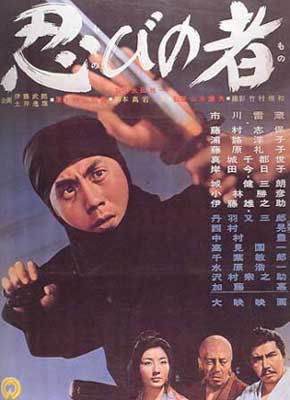The Ninja Ishikawa Goemon Trilogy
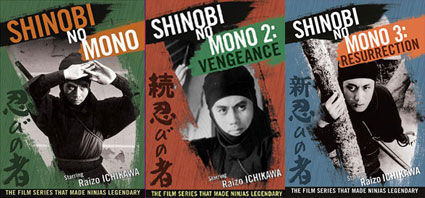 Raizo Ichikawa stars as ninja Ishikawa Goemon in the first three episodes of an eight-film series. These first three in the complete set form an epic unto themselves. Raizo Ichikawa stars as ninja Ishikawa Goemon in the first three episodes of an eight-film series. These first three in the complete set form an epic unto themselves.
Goemon was an historical figure of the Azuchi Momoyama Period (1573-1598). Little is known of the real Goemon other than he was a thief around Kyoto & was captured & executed in 1594 by being boiled alive.
The films were based on the nihilistic pulp serials of Tomoyoshi Murayama (1901-1977), who in spite of writing adventure fiction gained a respectable reputation as a true artist. Before the war he was a member of the Japan Communist Party, & continued throughout his creatiive life to work out various degrees of proletarian activism in novels, plays, & visual arts, as he believed in "scientific socialism" besides being influenced from an early age by European avant-garde art movements.
Murayama perceived ninja as being accomplished spies, & Goemon in particular as being set upon a devout mission to undermine the highest authorities, yet destined both as a class of warriors & as individuals to be foiled by governmental powers beyond their comprehension. Murayama's vision coincided with that of far-left director Satsuo Yamamoto.
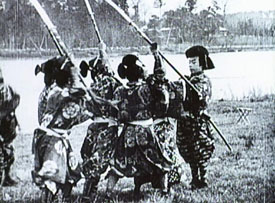 It is often said that Shinobi no mono (Band of Ninja, Daiei, 1962) was the first film to treat the ninja seriously & realistically. Formerly the theme of ninjas was regarded as kids' stuff, with flying warriors able to do actual magic. It is often said that Shinobi no mono (Band of Ninja, Daiei, 1962) was the first film to treat the ninja seriously & realistically. Formerly the theme of ninjas was regarded as kids' stuff, with flying warriors able to do actual magic.
This norm was set in the silent era when simple camera tricks, & the influence of camera magician Georges Mileas, inspired such films as Gogetsu Jiraiya (Gallant Jiraiya; aka, Hiro Jiraiya, Nikkatsu-Mukojima, 1921), itself a remake of the same actor & director's Jiraiya (1914) which does not survive, .
The name Jiraiya means "Young Thunder," & the character originated in a multiply-authored pulp serial that ran forty-three booklet installments over a long period, 1839 through 1868, then migrated to the kabuki stage by the 1850s, long before the arrival of silent films. He was always at odds with landed lords so qualified as a hero of the common people.
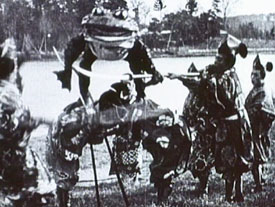 Twenty-one minutes is all that survives of the silent Gogetsu Jiraiya which starred kabuki-style screen idol Matsunosuke Onoe, under clownishly heavy make-up straight from the kabuki theater. Twenty-one minutes is all that survives of the silent Gogetsu Jiraiya which starred kabuki-style screen idol Matsunosuke Onoe, under clownishly heavy make-up straight from the kabuki theater.
Onoe was beloved of children who knew him as "Eyeballs Matsu," & even the names of the other troupe members seen hopping around him in the action scenes were once well known.
Performing acrobatically in "one against all" fight scenes, ninja Jiraiya had the ability to vanish & rematerialize at will, journey into clouds, & even turn into a toad. A couple stills from this film decorate this passage of this essay, which give a pretty good indication of the charming goofiness ninja legends tended to inspire.
With Shinobi no mono this would change for some years, though in time ninja films reverted to the goofy in big teen epics full of impossible acts. The film noir ninja tales of the 1960s were the height of the theme as artful, serious fair.
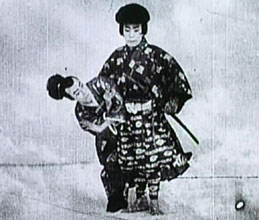 An actual ninja master, Hatsumi Masaaki, orchestrated the ninjitsu methods so that they would be more or less realistic, allowing for only a few cinematic or mythic exaggerations. An actual ninja master, Hatsumi Masaaki, orchestrated the ninjitsu methods so that they would be more or less realistic, allowing for only a few cinematic or mythic exaggerations.
While there were in fact a few earlier ninja films that were pretty serious, a combination of director Satsuo Yamamoto's vision & political point of view, & the beauty of Raizo Ichikawa in a ninja costume, pretty much redefined the ninja in popular imagination, cementing what to this day many people accept as the central ninja imagery.
When English author Roald Dahl saw Shinobi no mono on a visit to Japan, he was sufficiently impressed to borrow from it for his screenplay for the James Bond script of You Only Live Twice (1967), including the villainous Oda Nobunaga's fondness for stroking cats imitated by Blofeld in the Bond movie & by Dr. Evil in the Austin Powers movies, plus inspiring further spoofing when Blofeld's or Evil's cat personally tried to take over the wold in Cats & Dogs (2001).
More importantly, Mike Stone & Sho Kusogi in a series of American action-films beginning with Enter the Ninja (1981) were deeply inspired by Raizo Ichikawa's ninja films. They were also imitated by the Hong Kong film industry, so that Raizo's performances telegraphed the look & nature of ninjutsu throughout the world in films, comic books, & television.
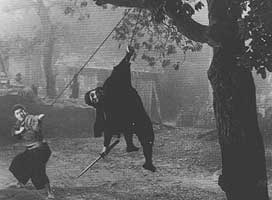 I. Shinobi no mono
I. Shinobi no mono
Shinobi no mono sets a dark, tragic mood right from the opening shot of crows perched over a quiet battlefield of the dead. A sinister ninja creeps up on a body to rob it, but the corpse is actually another ninja in peasant garb playing dead. This is Ishikawa Goemon, who leaps up & chastises the rival ninja as a vulturous thief. Goemon's disgust with thievery will become an increasingly important theme to the story.
The moody black & white photography captures the downbeat tone. Even so, we will within moments have a portrait of Goemon as rather naive, offered a job as bookkeeper for his ninjutsu clan's master Sandayu Momochi (Yunosuke Ito) of the Momochi style ninjutsu. Goemon believes his new position proves he is rising in the ninja world & will be a great success. His father warns him ninjas are born in obscurity, will die in obscurity, & in between are no causes for pride or pleasure. Goemon readily agrees, but with a jolly smile the audience already realizes will soon be wiped from his face.
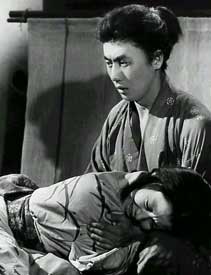 The master ninja sets up Goemon for a fall, using his weakness for women & providing ample opportunity for the young ninja to seduce the sexually frustrated young wife (Kyoko Kishida) of the master ninja. Since their marriage, her husband has never touched her, & she lives a bewildered lonely life fearful there is something wrong with her. In her isolation, she falls for the handsome bookkeeper instantly. Soon they are having dangerous trysts, never realizing the master ninja watches them from the rafters. The master ninja sets up Goemon for a fall, using his weakness for women & providing ample opportunity for the young ninja to seduce the sexually frustrated young wife (Kyoko Kishida) of the master ninja. Since their marriage, her husband has never touched her, & she lives a bewildered lonely life fearful there is something wrong with her. In her isolation, she falls for the handsome bookkeeper instantly. Soon they are having dangerous trysts, never realizing the master ninja watches them from the rafters.
The Momochi master ninja orchestrates the situation with the housekeeper Hata (Reiko Fujiwara) as witness to the unmasking of the illicit affair. Sandayu kill his wife but in a manner that makes it look like Goemon killed her. Goemon flees the fortressed ninja village, but is waylaid by his master, who promises to spare his life if he will become a burglar bringing funds into the ninja camp in their struggle against Oda Nobunaga (Tomisaburo Wakayama), & instructs him to await the correct moment to assassinate Nobunaga himself.
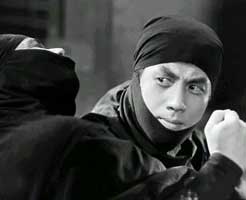 Burglary is against the ninja code, but Goemon has no choice. He has gone from a naive belief in his own future successes in the shadowy world of the ninja, to being a shadow among shadows, demeaned as "half ninja, half thief" & enslaved to his master's whims, not realizing he was set up from the beginning for just this purpose. Burglary is against the ninja code, but Goemon has no choice. He has gone from a naive belief in his own future successes in the shadowy world of the ninja, to being a shadow among shadows, demeaned as "half ninja, half thief" & enslaved to his master's whims, not realizing he was set up from the beginning for just this purpose.
Rival ninja groups are after the life of Oda Nobunaga, who has induced civil war in his attempt to unite all Japan under his iron fist. The Iga Province ninja groups are freelance spies who serve whoever hires them, but in the present case, because Nobunaga has destroyed the Buddhist temple of ninja families, they have taken it upon themselves to strive against Nobunaga's machinations even without being hired for the purpose. The two ninja groups compete for success, working against one another even though for a common goal.
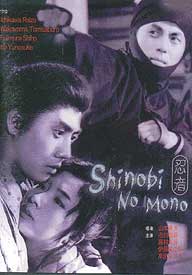 Rival master ninja Yunosuke Ito of the Ito style ninjutsu is a loud man with long white hair & large appetites with his young wife. He drums into his spies an enthusiasm for outcompeting the Momochi spies. Rival master ninja Yunosuke Ito of the Ito style ninjutsu is a loud man with long white hair & large appetites with his young wife. He drums into his spies an enthusiasm for outcompeting the Momochi spies.
Sandayu Momochi by contrast is taciturn & balding & has no interest in his wife's sexual needs. He drums into his spies the sense that for the sake of Buddhism which Nobunaga has insulted, his school must out-perform that of the Ito group.
But in reality these two master ninja are the same man living a double life, having created two distinct ninja schools in the belief that their competitions with one another will hone their skills. Nothing in the ninja world is as it seems, & even the ninja themselves do not know what is or isn't real.
Goemon meanwhile has fallen into a depression over his position as a thief & has stopped delivering funds to his contact, nor has he made any move against Nobunaga. Instead, he hangs out at a low bordello where he has fallen in love with Maki (lovely Shiho Fujimura, Raizo's love-interest & co-star in many a film). He wants to retire from ninja life altogether, redeeming Maki of her debt so they can live in some out of the way place & raise a family.
This dream, too, is held against him as a control measure, & he is forced to make his assassination attempt or the Momochi ninja master will have Maki killed.
The method of assassination is tense & clever, one of many scenes that show the shadowy ninja methods. Soon Nobunaga is surrounded by attendants & a physician unable to figure out why he is raving & close to death.
Inevitably Goemon finds out he was the dupe of his master's heartless plots, & was even the one who killed Goemon's father. As twisted luck would have it, Nobunaga survives the assassination attempt & attacks the fortressed village of Iga spies, killing everyone, including all those who had troubled Goemon & Maki.
For such a gloomy, gloomy story it has a sunny upbeat ending. Since everyone who knows him is dead, Goemon & Maki can live happily ever after, & the naive smile we saw early in the film is back on Goemon's face.
If this had been the only episode of Shinobi no mono we might really stand in awed surprise that for once in a Japanese film, everything came out well for the hero & heroine. Ah, but happy endings are frequently just building a character's expectation specifically to dash his life to pieces in sequels.
This is a beautifully done film throughout. It can be hard to follow the feudal politics among warlords if a viewer isn't already steeped in Japanese history, but even allowing for a little confusion, the film works tremendously well. It is packed with ninja action start to finish, but it manages to find time for decent characterization. It's the atmospheric wide screen landscapes & portraits, & the film noir cinematography & moody sense that the ninja world is tainted with a sinister aura, that makes Shinobi no mono a great deal more than just an action picture.
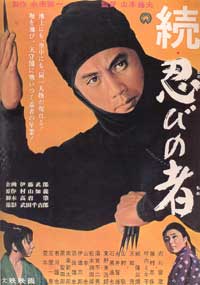 II. Zoku shinobi no mono II. Zoku shinobi no mono
Had this film series been made any later in cinematic history, it is not likely to have been shot in black & white, & the classy film noir beauty of the films would not have existed.
When last we saw our hero Goemon, he was trying to live happily ever after with Maki, leaving the ninja world behind to live as a hunter & fisherman in a forest home.
At the opening of Zoku shinobi no mono (Return of a Band of Assassins, 1963), the strength of the Iga spies has already been shattered by Oda Nobunaga.
But Nobunaga well knows some few of them are still hiding in the guises of farmers, priests, vendors, & he arranges increasingly vicious methods of torture & execution with the intent of bringing an exterminating reign of terror upon these warriors of the shadows.
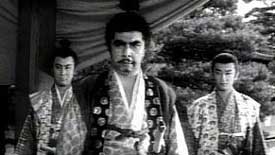 Goemon's idyll lasts six months before the bounty on ninjas brings killers to the door of his woodland home. Goemon's idyll lasts six months before the bounty on ninjas brings killers to the door of his woodland home.
In the ferocious action sequence, Maki & Goemon's infant is horrifically slain.
Goemon slays all the attackers then the griefstricken mother & father flee to Saiga where Nobunaga's influence does not yet reach.
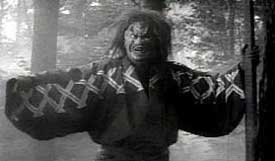 For the loss of his child, Goemon swears personal vengeance on Nobunaga & takes up a position as a ninja master teaching the methods to Saiga spies. His buddhism deepens, & Saiga men (themselves buddhists) bide their time for the right moment to strike at Nobunaga. For the loss of his child, Goemon swears personal vengeance on Nobunaga & takes up a position as a ninja master teaching the methods to Saiga spies. His buddhism deepens, & Saiga men (themselves buddhists) bide their time for the right moment to strike at Nobunaga.
Characterization counts for a lot in this film, but so does action, & the story is punctuated with moments of shocking brutality.
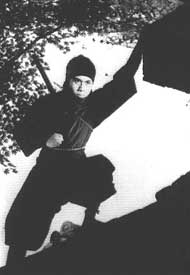 Examples of this harsh cruelty include the priest who refused to leave his buddhist temple when Nobunaga burned it down, praying as flames rise up around him; the shocking murder of Goemon's infant; the display of the heads of Saiga men on pikes. Such extreme occurrences are captured in brief artful shots. Examples of this harsh cruelty include the priest who refused to leave his buddhist temple when Nobunaga burned it down, praying as flames rise up around him; the shocking murder of Goemon's infant; the display of the heads of Saiga men on pikes. Such extreme occurrences are captured in brief artful shots.
The great scene of Goemon's very personal vengeance against Nobunaga comes halfway through the film rather than as the climax.
It's an extended sequence of extreme & graphic grotesquery, having a certain beauty but might be a little stomach-turning to anyone not already initiated in the grimmer sorts of samurai films.
The restoration of peace for Goemon & Maki in Saiga comes quickly on the heals of this success against Nobunaga, & they take up life as farmers.
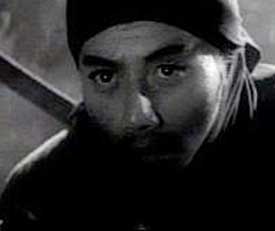 But both historically & by genre convention, quiet interludes in the Warring States Period never lasted. But both historically & by genre convention, quiet interludes in the Warring States Period never lasted.
And Goemon is destined to lose everything he loves at the hands of Hideyoshi (Eijiro Tono), who steps into Nobunaga's campaign of terror, & Goemon is again full tilt in ninja action.
If there had only been two films for the series, the ending would've been one of the more shocking imaginable as Goemon clad in white garments & bound in ropes is marched toward his horrific demise, to be boiled alive, as history tells us really happened. Since it's only the second of a three-film set, however, it functions more as a cliffhanger, & quite a good one.
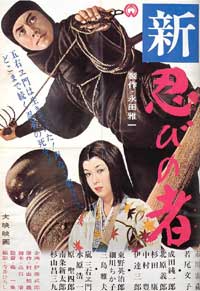 III. Shin shinobi no mono III. Shin shinobi no mono
The first two films of this series were directed by far-left-leaning Satsuo Yamamoto, whose socialist or communist politics influenced his attitude in structuring this dark vision of feudalism, to function as a parable of modern capitalism, where the few in power injure & exploit the many who struggle for little gain.
The directors who took over the series did not greatly change the gloom & doom heroism of ninjas as morally dubious underdogs in perpetual struggle against authority.
Issei Mori directed the last episode about Goemon, & although the fourth episode about Mist Saizo re-starts with a different character, essentially Raizo plays the same character type in all eight films.
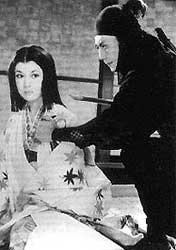 In Issei Mori's Shin shinobi no mono (Ninja Goemon Will Never Die, 1963), the gloominess of Goemon personality loses even its interludes of happiness & he is by now clearly a tragic hero doubting even Buddha. In Issei Mori's Shin shinobi no mono (Ninja Goemon Will Never Die, 1963), the gloominess of Goemon personality loses even its interludes of happiness & he is by now clearly a tragic hero doubting even Buddha.
Saved from being boiled alive by his ninja friend & Tokugawa advocate Hanzo Hattori (Saburo Date), Goemon refuses Hanzo's suggestion that he officially serve Ieyasu Tokugawa, though Goemon's actions will in any case serve the Tokugawa interests.
He is hard on the road of vengeance against Toyotomi Hideyoshi, but wants Hideyoshi's suffering to linger, so terrorizes Hideyoshi's child & mistress (Ayako Wakao) & otherwise undermines his regime & his sense of safety.
This is no assassination as when Goemon's ninja tactics took down Oda Nobunaga. This time he's sharing just the right information here & there, snippets provided to the right individuals to incite paranoia & betrayals until Hideyoshi loses his dynastic aspirations.
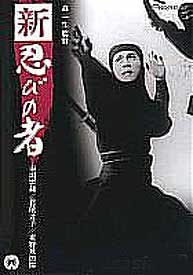 As an aside, the figure of Hanzo Hattori is one of the few characters in the film who is not shown to be capable of great cruelty, though his presense is too subdued for him to be regarded as one of the film's heros. As an aside, the figure of Hanzo Hattori is one of the few characters in the film who is not shown to be capable of great cruelty, though his presense is too subdued for him to be regarded as one of the film's heros.
He is a hero, however, when played by Sonny Chiba in Shogun's Samurai (Yagyu Ichizoku no Inbo, 1978) or by Hashizo Okawa in The Red Shadow (Akai kageboshi, 1961), so the character obviously has some distinction beyond his Shinobi no mono appearances. Saburo Date in this role will reappear in the first two "Mist" Saizo episodes of the Shinobi series, still serving Ieyasu.
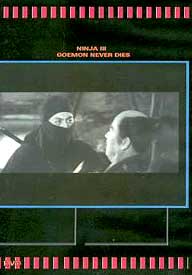 Goemon's malice is boundless, & the idea is sustained that one man in the shadows, with no desire for personal gain beyond vengeance, can direct the course of history. Goemon's malice is boundless, & the idea is sustained that one man in the shadows, with no desire for personal gain beyond vengeance, can direct the course of history.
The film has plenty of action, but what is fascinating about the climactic encounter between Goemon & Hideyoshi is its singular lack of action, as by then Goemon's subtler machinations have destroyed all hope of a dynasty for the Toyotomi clan.
The whole of the centuries-long & peaceful "Tokugawa era" therefore occurred because of one man who never stepped from the shadows, & never accepted any rewards or honors since vengeance was his sole intent.
And yet there is always "on the other hand," & the bittersweet success of Goemon only means yet another warlord will fill the vaccuum. These forces are their own malevolent power, changeless even if the players change.
Ishikawa Goemon's story is completed, & when the fourth Shinobi no mono film appeared, Raizo would be another though very similar character adventuring in the same Warring States period, "Mist" Saizo, & if possible the series increases in film noir cynicism & nihilism of the shadows.
copyright © by Paghat the Ratgirl
|

